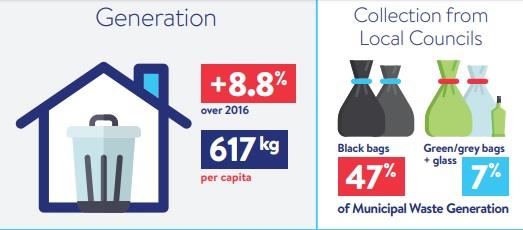During 2017, municipal waste generation increased by 8.8% when compared to the previous year, the National Statistics Office said.
Administrative data provided by WasteServ Malta Ltd. and the Environment and Resources Authority show that, during 2017, municipal waste generation amounted to 293,557 tonnes, up by 23,720 tonnes over 2016.
This increase was mainly driven by higher amounts of mixed municipal waste (10,930 tonnes) and bulky waste (10,160 tonnes). This was partly offset by a decrease in the generation of wood waste (2,680 tonnes).
The data breakdown by waste origin shows a decrease of 3,283 tonnes or 18% in the volume that was collected from the civic amenity sites. On the other hand, municipal waste collected by means of both the door-to-door grey/green bag as well as the glass collection scheme increased by 3,622 tonnes or 21.2% to reach 20,735 tonnes.

Waste collected through the black bag also advanced by 2,627 tonnes coming from local councils and by 8,303 tonnes arising from other sources. Also, during the same year, organic waste collection rose by 892 tonnes or 41.3% primarily as a result of Gozo’s inclusion in the pilot project for the collection of the same kind of waste in September 2016.
During 2017, the total amount of municipal waste treatment increased by 11.5% over 2016; reaching a total of 264,744 tonnes. The share of landfilling from the total municipal waste treated stood at 92%.
The total amount of landfilled digestate, refuse-derived fuel and rejects shows that 37.3% of all landfilled municipal waste underwent a pre-treatment process prior to its final disposal.
Municipal waste recycling comprised the remaining 8% of the total municipal waste treatment. When compared to a year earlier, municipal waste recycling advanced by 2,261 tonnes.
Municipal waste recycled was mainly made up of paper and cardboard (36.3%), metals (29.5%) and plastic (11.2%).